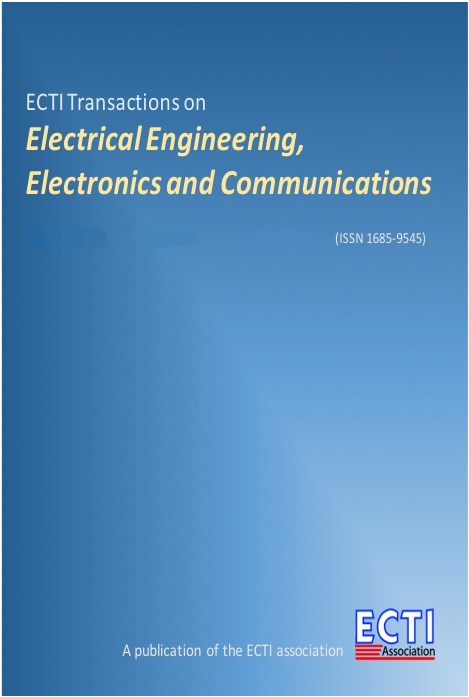Modified Koch Fractal Antenna for Multi and Wideband Wireless Applications
Main Article Content
Abstract
This paper focuses on the design and development of modified Koch fractal antenna. Compared to traditional Koch curve antenna, the presented antenna possesses a greater number of frequency bands and better impedance matching. Furthermore, the bacterial foraging optimization (BFO) approach is implemented to enhance the impedance bandwidth. The developed technique has been verified by employing various numerical simulations. The design parameters generated from the optimization procedure have been utilized to manufacture the antenna and the respective experimental and simulated results compared. The measured results show that the designed antenna exhibits multi and wideband behavior, covering WLAN, WIMAX, and various other wireless applications.
Article Details
This journal provides immediate open access to its content on the principle that making research freely available to the public supports a greater global exchange of knowledge.
- Creative Commons Copyright License
The journal allows readers to download and share all published articles as long as they properly cite such articles; however, they cannot change them or use them commercially. This is classified as CC BY-NC-ND for the creative commons license.
- Retention of Copyright and Publishing Rights
The journal allows the authors of the published articles to hold copyrights and publishing rights without restrictions.
References
D. Li and J. Mao, “A Koch-like Sided Fractal Bow-Tie Dipole Antenna,” IEEE Transactions on Antennas and Propagation, vol. 60, no. 5, pp. 2242–2251, 2012.
D. H. Werner and S. Ganguly, “An Overview of Fractal Antenna Engineering Research,” IEEE Antennas and Propagation Magazine, vol. 45, no. 1, pp. 38–57, 2003.
L. Lizzi, R. Azaro, G. Oliveri, and A. Massa, “Printed UWB Antenna Operating Over Multiple Mobile Wireless Standards,” IEEE Antennas and Wireless Propagation Letters, vol. 10, pp. 1429–1432, 2011.
K. J. Vinoy, J. K. Abraham, and V. K. Varadan, “On the Relationship between Fractal Dimension and the Performance of Multi-Resonant Dipole Antennas Using Koch Curves,” IEEE Transactions on Antennas and Propagation, vol. 51, no. 9, pp. 2296–2303, 2003.
M. Comisso, “Theoretical and Numerical Analysis Of The Resonant Behaviour of The Minkowski Fractal Dipole Antenna,” IET Microwaves, Antennas & Propagation, vol. 3, no. 3, pp. 456–464, 2009.
S. Rani and A. P. Singh, “On the Design and Optimization Of New Fractal Antenna Using PSO,” International Journal of Electronics, vol. 100, no. 10, pp. 1383–1397, 2012.
S. Rani and A. P. Singh, “Modified Koch Fractal Antenna With Asymmetrical Ground Plane For Multi And UWB Applications,” International Journal of Applied Electromagnetics and Mechanics, vol. 42, no. 2, pp. 259–267, 2013.
J. K. Ali, A. J. Salim, A. I. Hammoodi, and H. Alsaedi, “An Ultra-Wide Band Printed Monopole Antenna With Fractal Based Reduced Ground Plane,” in Progress in Electromagnetics Research Symposium Proceedings, Moscow, Russia, 2012, pp. 613–617.
A. Gorai, A. Karmakar, M. Pal, and R. Ghatak, “Multiple Fractals –Shaped Slots Based UWB Antenna With Triple-Band Notch Functionality,” Journal of Electromagnetic Waves and Applications, vol. 27, no. 18, pp. 2407–2415, 2013.
S. Kakkar and S. Rani, “Implementation of Fractal Geometry to Enhance The Bandwidth of CPW Fed Printed Monopole Antenna,” IETE Journal of Research, vol. 63, no. 1, pp. 23–30, 2017.
M. Jahromi, A. Falahati, and R. Edwards, “Bandwidth and Impedance Matching Enhancement of Fractal Monopole Antennas Using Compact Grounded Co-Planar Waveguide,” IEEE Transactions on Antennas and Propagation, vol. 59, no. 7, pp. 48–56, 2011.
K. Passino, “Biomimicry of Bacterial Foraging For Distributed Optimization And Control,” IEEE Control Systems Magazine, vol. 22, no. 3, pp. 52–67, 2002.
T. Datta and I. Misra, “A Comparative Study of Optimization Techniques in Adaptive Antenna Array Processing: The Bacteria-Foraging Algorithm and Particle Swarm Optimization,” IEEE Antennas and Propagation Magazine, vol. 51, no. 6, pp. 69–81, 2009.
M. Tripathy and S. Mishra, “Bacteria Foraging-Based Solution to Optimize Both Real Power Loss And Voltage Stability Limit,” IEEE Transactions on Power Systems, vol. 22, no. 1, pp. 240–248, 2007.
B. Mangaraj, I. Misra, and A. Barisal, “Optimizing Included Angle of Symmetrical V-Dipoles For Higher Directivity Using Bacteria Foraging Optimization Algorithm” Progress in Electromagnetic Research B, vol. 3, pp. 295–314, 2008.
S. Sharma and B. Kanujia, “Optimization of Resonant Frequency of Circular Microstrip Antenna With And Without Air Gaps Using Bacterial Foraging Optimization Technique,” in IEEE International Conference on Computational Intelligence and Communication Systems, 2011, pp. 574–577.
D. Mandal, R. Kar, and S. P. Ghosal, “Bacterial Foraging Optimization Based Synthesis of Concentric Circular Antenna Array,” in IEEE International Conference on Recent Trends in Information Systems, Kolkata, India, 2011, pp. 99–104.
J. Liu , Y. Liu, D. Chang, C. Chang, and C. Cheng, “Fractal Multiband Antennas based on Lotus Pod Patterns,” Microwave and Optical Technology Letters, vol. 30, no. 3, pp. 223–228, 2002.
B. R. S. Reddy and D. Vakula, “Compact Zigzag-Shaped-Slit microstrip antenna with circular defected ground structure for wireless applications,” IEEE Antenna and Wireless Propagation Letters, vol. 14, pp. 678–681, 2015.
W. Liu, C. Wu, and Y. Dai, “Design of triple frequency microstrip fed monopole antenna using defected ground structure,” IEEE Transactions on Antennas and Propagation, vol. 59, no. 7, pp. 2457–2463, 2011.


